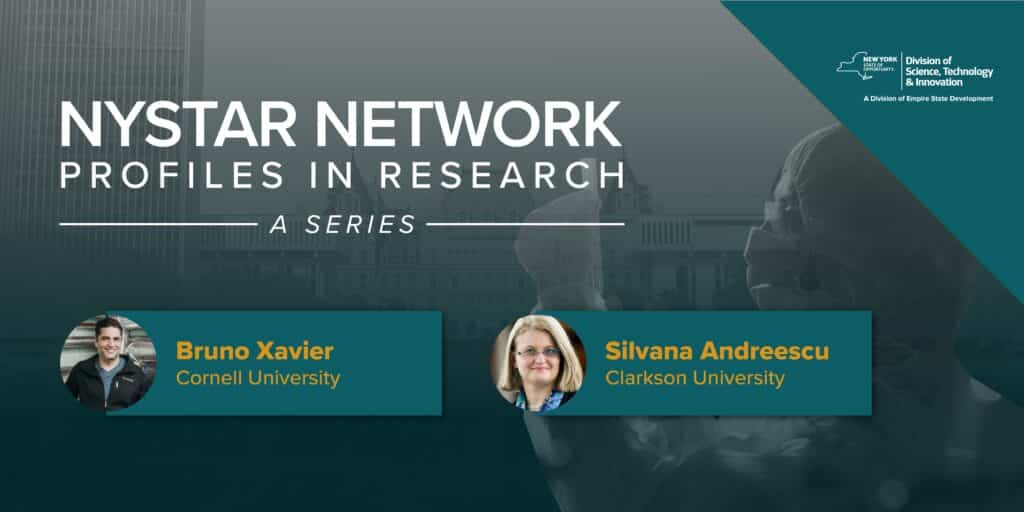Researchers at Cornell and Clarkson are making discoveries that can shake up the food and agriculture industries
It starts with curiosity.
That’s where the science nearly always begins, leading researchers to discoveries — both of what works and what doesn’t.
These days, thanks in part to collaborations with businesses across New York State, curiosity is leading researchers out of their specialty silos into interdisciplinary projects. It’s work with potential that can lead to game-changing industry innovations.
Bruno Xavier and Silvana Andreescu are two researchers leading cutting-edge, interdisciplinary teams that are having a significant impact on the food and agriculture space. Their work is a key resource for entrepreneurs and food manufacturers across New York State’s Division of Science, Technology and Innovation (NYSTAR) network.
At Cornell, Xavier is leading the Fermentation Farming Lab, while at Clarkson, Andreescu leads a team of students applying sensor technology to food packaging to address spoilage and waste.
The disruptive capabilities of fermentation farming
A native of Brazil, Xavier says farming runs in his blood. While his parents were the first generation to leave the farm, he felt a strong relationship to agriculture. Trained as a dairy technician in high school, he worked on a dairy farm to put himself through college where he studied food engineering. As a graduate student, he developed an appreciation for academia and interdisciplinary studies focused on sustainability, putting together his strengths in engineering and microbiology into the research of biofuels and alternative antibiotics.
A move into food safety research was his first opportunity to work with entrepreneurs. And that’s where the lightbulb came on.
“I was working with people that were dedicating their lives to these very audacious goals and loving that,” Xavier said. “I saw change in the food industry and a huge push toward sustainability. [People addressing] challenges [related] to the ways we make food were using the same technologies that I was using before in the production of biofuels. So, I decided to put some time into it, and it snowballed from there.”
Xavier now leads Cornell’s Fermentation Farming Lab, which supports potential disrupters in the food industry as entrepreneurs look to utilize new technology to increase nutritional value, remove allergens, and reduce the environmental impact of traditional farming practices. This includes the fascinating world of mushrooms and the ability of the fungi to transform food waste materials into proteins that mimic the properties of meat.
“The possibility of creating these types of protein and making them available to people without access to high quality protein is inspiring,” Xavier said. “That’s only happening because we are taking technologies that were developed in other sectors and applying them to food production systems. The type of work that we are doing is innovation. It is research that is fresh out of the oven.”
Applying the technology is an expensive and often prohibitive undertaking for small businesses and entrepreneurs, which is one of the reasons why the Fermentation Farming Lab was created in 2023. Thanks to its place in the NYSTAR network, the cost of using the Lab’s services to go from idea to proof of concept is accessible for smaller companies and start-ups looking to create new sources of protein for the world’s food supply.
Moving beyond the expiration date
During her 25-year career as a bioanalytical chemist, Andreescu has been researching ways to innovate sensors and sensing technology and convert those results from a laboratory into useful products for consumers.
Her latest research has focused on developing product sensors that would be incorporated into food packaging to indicate the freshness of food. Utilizing biocompatible packaging, the research focused on design formulations that were made of entirely of green and sustainable materials.
Using dyes that are responsive to freshness and safety indicators, the changing color on a package gives consumers information on if their food is spoiled. This provides a more accurate measure than the confusing world of “sell by,” “best by,” and “use by” dates, according to Andreescu. This in turn helps cut down on food waste and increases food safety.
“The fundamental work is processing these materials, making them mechanically strong, sensitive or responsive to biomarkers in food, and biodegradable,” Andreescu said. “When we started, this was more of scientific curiosity. We have advanced in the last two or three years to something we can consider a product ready for prototyping.”
That’s where researchers and industry come together.
The laboratory work was part of an inaugural student and faculty research program, Food Spoilage Mitigation through Packaging, funded through a grant from The New York State Pollution Prevention Institute (NYSP2I). Now, Andreescu and her team will work with the Center for Advanced Materials Processing (CAMP) at Clarkson, and part of the NYSTAR network, to connect with food manufacturing companies interested in collaborating on prototype testing.
One of the greatest strengths of this work for Andreescu is the opportunity to give students meaningful experience in research, opportunities to collaborate with industry partners, and exposure to the multidisciplinary work that will drive innovation in the future.
“This symbolizes the sort of investments from New York State in centers, like CAMP, that are really important for training the next generation and for bringing faculty, entrepreneurs and industry together,” Andreescu said. “It pays off in terms of student placements in really good jobs, but also in growing the reputation of researchers and New York State as a place creating these opportunities for businesses. Essentially if we want to see more of a translation from curiosity-driven research into a market-like culture, or from innovation to consumer use. This type of culture shift is important.”
These are just two examples of researchers who are part of the NYSTAR network supporting innovations in food and agriculture spaces. To learn more about NYSTAR and the resources available to innovators in New York, visit Empire State Development’s website.

